In most of Australia, native violets produce a stunningly delicate display of purple and blue flowers right through from summer to spring. These reliable ground cover plants are easy to care for, make a gorgeous replacement for low-traffic lawns, and are super easy to divide and propagate.
So, what are you waiting for? Dive into our native violet growing guide below and learn everything there is to know about growing, propagating, and harvesting native violet. That’s right, harvesting! These peppery little flowers are ideal in salads as well as in the garden.
More...
Family: | Violaceae |
|---|---|
Genus: | Viola |
Species: | Viola hederacea Viola banksii |
Common Names: | Australian Native Violet, Ivy Leaved Violet, Australian Violet, Tasmanian Violet |
Location: | Outdoor |
Type: | Herbaceous perennial |
Growth: | 15cm x 2m (H x W) |
Sun requirements: | Sun to shade |
Foliage Colour: | Blue and white, or purple and white |
Flower Colour: | Yellow |
Flowering: | All year |
Fruit: | None |
Maintenance level: | Low |
Poisonous for pets: | Edible flowers and leaves. Seeds are mildly toxic. |
What is Native Violet?
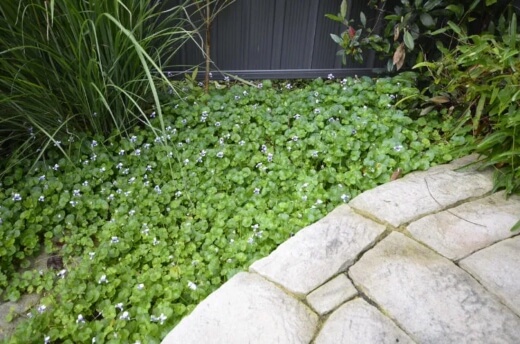
Source: planttiles.com.au
Native violet is a low-growing native perennial, grown for its dense ground-cover foliage and gentle swathes of misty blue petals that hover seamlessly over its leaves.
Native violet spreads through seed, and through runners, which pop up next to their parent plant until your soil is covered in precious gems, helping to suppress weeds and elevate any canopies of taller plants that are able to burst through.
Despite being fast spreaders, native violets are actually quite easy to control, and typically not considered invasive, or hard to manage. Simply digging up clumps can slow spreads down by a few years.
Native Violet’s Natural Habitat
Despite Viola being one of the most effective self-seeding plants in the natural world, there are only two native Viola species in Australia; Viola hederacea, and Viola banksii.
Both are low-growing species, spread predominantly through runners, and fare better in our climate than most thanks to tougher foliage and a better ability to store water.
Viola hederacea is native to Victoria and Tasmania but can be found right through from Queensland to New South Wales and Adelaide.
Viola banksii is only truly native to New South Wales but is quickly naturalising around the rest of the country as it is more popular in cultivation.
Best Native Violet Cultivars to Grow in Australia
1. Viola hederacea

Source: littleprinceplants.com
The most common native violet in Australia is V. hederacea, but it is uncommon to find one in a garden centre as their foliage is duller, with paler petals than their more vibrant cousins.
For a true native violet though, V. hederacea is the simplest flower, and much better for pollinators than ornamental alternatives.
V. hederacea typically grows at single 15x15cm plants in clusters of around 2m wide, with deep, matt green foliage and a pale purple, single stemmed flower which fades to white on the petal borders.


Get Your Free Guide:
Master Growing Australian Natives eBook
A Must Have Complete Guide for Every Australian Garden
Get Your Free Guide:
Master Growing Australian Natives eBook
A Must Have Complete Guide for Every Australian Garden
2. Viola banksii

Source: anpsa.org.au
V. banksii makes up most of the commercial native violet market, with brighter foliage and deeper colour ranges in its blooms. V. banksii was initially mistaken for V. hederacea, but later reclassified as a separate species due to typically larger, brighter foliage.
Today, there are several popular cultivars bred for specific border arrangements, but the original vividly violet-coloured V. banksii is the most common in our gardens.
3. Viola banksii ‘Baby Blue’
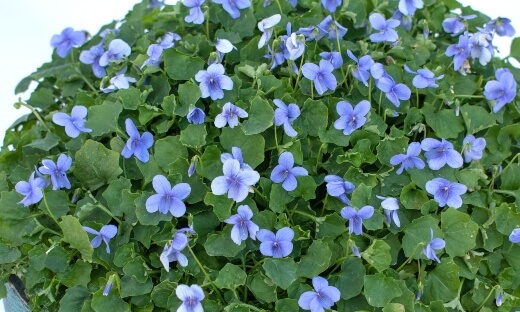
Source: pga.com.au
Viola ‘Baby Blue’, as the name suggests has the same dense, matt-forming carpet of foliage as common V. banksii, but with a delicate and uniform coloured set of petals which bloom reliably throughout the year, but most prominently in spring, preferring shaded moist soil conditions.
4. Viola banksii ‘White Glory’
Viola ‘White Glory’ retains the typical purple or violet coloured centres to each bloom, but with longer stalks and longer runners, making them much more fitting as ornamental plants for pots or container gardeners.
They are not as hardy underfoot as most native violets but still work well as a low-maintenance lawn alternative in moist conditions.
How to Grow Native Violet
Native violet can be planted at any time of year, in almost any conditions, provided that young plants aren’t subjected to heat waves or heavy flooding in the first few weeks.
If extreme weather Is predicted, keep any young plants out of harm’s way until the weather settles. Native violets can be planted as seeds or young plants, and prefer reasonably fertile, moisture retentive soil without too much compaction.
So, if you are considering replacing a lawn, the soil will need aerating, and possible tilling before you re-plant native violets or any other ground cover in the place of an existing grass lawn.
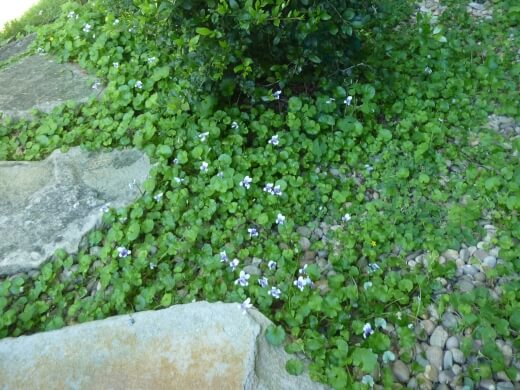
Source: gardeningwithangus.com.au
Best Soil for Viola
Viola can be planted in the ground, or in containers in almost any planting medium, but prefers moisture retention, and a reasonable amount of nutrition while it establishes.
The only soil type that native violets don’t enjoy is pure sand. Anything from Clay, to loamy sand, is fine. Pure compost or potting mix is fine for violas planted in containers.
Read our guide to learn more about potting mix, their types, and the best ones available online.
Light
Violas are woodland plants that thrive in moist, shaded conditions, so try to find somewhere away from direct afternoon light if possible.
Don’t worry if that’s not possible though, as violas can grow in almost any conditions other than complete darkness. Dappled light or partial shade is ideal though.
Temperature
While violas are naturally happier in cooler parts of Australia they can cope in the warmer Northern states with some shade and more generous watering through summer.
There is no need to protect any native violet from frost as they, like all violets, are completely hardy. Even if the top dies back over winter, roots will burst back into life in spring, which can actually help to reinvigorate faded plants.
Water
Until violets have established they should be watered once a week. Once they have begun flowering or sending out runners to create new plants, it’s safe to assume they are settled into their new homes.
At that point, native violets don’t need any extra water other than through droughts and heat waves.
How to Propagate Native Violet
Native violet does most of the propagation work for you. It’s an easy self-seeder, and will always be on the lookout for open soil for its runners to root into.
If you want to propagate new plants, there are three incredibly simple ways to do it.
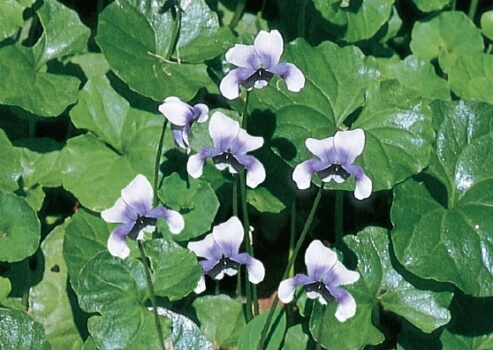
Source: plantnative.com.au
Growing Native Violet from Seed
Deadheading native violet does very little to extend its flowering time as any unpollinated flowers will naturally drop from the plant anyway. Pollinated flowers swell into conical seed pods, which open out in three sections when ripe.
If you notice ripe seeds, simply drop them onto the surface of any clean compost and water them really well. Leave them in a warm but shaded spot and you should see seedlings appear within two to three weeks.
Thin seedlings to about 10cm apart, and keep the soil moist, but not damp. After a few months, you’ll have viola plants ready to plant anywhere in the garden.
Native Violet Propagation from Division
Because native violets spread so easily they can quickly outgrow their space. However, by digging up clumps of V. banksii or V. hederacea you can slow their spread, and get healthy, mature clumps ready to plant anywhere else in the garden immediately.
Just dig around healthy clumps with a spade or garden fork, then plant them in loosened soil, anywhere slightly shaded. For the first few weeks they’ll look a little bit sad and wilted, but be patient. The moved clump should flower again the same year.
Propagating Native Violet from Runners
If you’ve ever propagated strawberries from runners, the process of propagating native viola is much the same. Find long stems that are trying to crawl away from their parent plant, usually with a small group of leaves at the end, and peg them into a small plastic pot, filled with fresh compost.
Water the container, and leave the plant for around four weeks, still attached to its parent. Once the runner has rooted into the new pot (new leaves will show, or roots will be visible from the holes at the base of the pot), plant it somewhere else in the garden, or give it to a friend to start their own viola lawn.
How to Care for Native Violet
There are a few different ways to care for established native violets, and each depends on what you ultimately want the plant to do. Remember, native violets can be attractive groundcover and even lawns, but they can also be used for stunning container displays.
How you care for them determines how, and when, they perform.
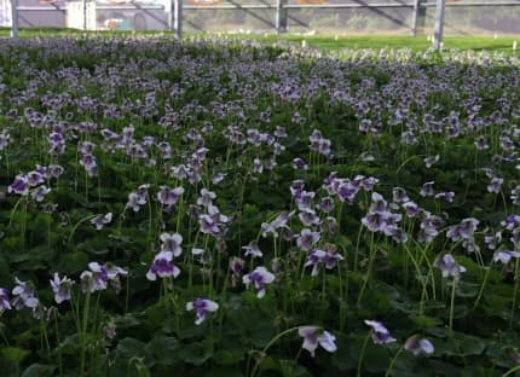
Source: gumtree.com.au
Mulching Native Violet
Native violets do not need any mulch. They are effective ground cover plants and help to shade their own soil from the sun to retain good moisture levels.
However, for container-planted violas, a light mulch of fresh compost every year will provide the nutrients they need to boost any spent compost.
Fertiliser for Native Violet
Ground cover violas or lawn violas need very little fertiliser, but do benefit from a gentle sprinkle of high nitrogen feed every so often. Standard lawn fertiliser can work very well here.
Essentially you’re using nitrogen to boost foliage and top growth. This focuses the plant’s energy on green growth, rather than blooms.
For containerised violas, use a low nitrogen feed, or one which is higher in phosphorus and potassium. This promotes flowering for longer through the year, and is particularly beneficial for ornamental native violets like Viola banksii ‘White Glory’.
Pruning and Repotting
As an herbaceous perennial, native violets don’t really need any pruning unless you notice patches of dead foliage or soggy leaves.
Remove any damaged or diseased clumps of violas as and when you see them. Don’t worry, they’ll quickly grow back to fill in the empty space.
When viola begins to outgrow its space, it’s worth cutting the plant back by digging up larger clumps from around the edge. You can plant these elsewhere or compost them if there’s not enough space.
Remove slightly more than you need as they will grow back out into the empty space within two to three years.
Harvesting Native Violet
Native violet isn’t the best-known bush tucker plant in the world, and certainly shouldn’t be relied on as a food source (it has very little nutritional value), but it’s a great way to spice up a salad thanks to its lightly peppered leaves, and edible flowers that add colour and flavour to salads and cakes.
Click here to see our full list of edible flowers you can grow in Australia.
All violas are edible, but few have a good enough leaf structure to last in a salad. The sturdy foliage of native violets adds a texture to a simple salad.

Source: gumtree.com.au
How to Prepare Native Violet
The only thing to be careful about when harvesting native violets, is pest damage and cleaning your harvest. As native plants they provide habitat for ground-nesting insects, and as edibles are often grazed on by wildlife.
Flowers are generally safe to eat, and submerging them in water can ruin their texture and look, so give them a quick check and discard any with signs of insects, or damage.
Viola leaves should be submerged in cold water, then spun in a salad spinner to clean them. Alternatively, grow native violets in a container on a table or windowsill to keep them out of harm’s way to being with.
Australian Native Violet Pests and Diseases
Aside from very typical garden pests and diseases, Australian native violets are pretty much bulletproof. However, we’ve put together a list of common problems for native violets to help you keep on top of your pants, particularly if you’re growing them for bush tucker.
Aphids
Aphids love native violets because they have fresh growth for almost twelve months of the year. Aphids, the small white, black, or green flies that gather in dense groups on new growth of herbaceous and annual plants, do little harm to your plants but will ruin a harvest.
To prevent aphids on bush tucker violets, net your crop in early spring, or plant companion plants like basil or marigolds which help to deter them.
There’s no reason to spray aphids on violas as they cause very little damage to plants, and even organic sprays will ruin the flavour of a leaf crop.
Check out our guide to know more about the types of aphids and how to get rid of them organically.
Spider mites
Spider mites are a big problem on native violets in Western Australia as the drier conditions are ideal for them, and they thrive in the humid undergrowth away from otherwise dry gardens.
The only effective way to get rid of spider mites, which spin unsightly silk webs across whole fields of violets, is to introduce predators.
Plants pollen-rich plants to attract wasps, and encourage ladybirds into the garden with flat-topped flowers like fennel or angelica.
Nematodes
Because Australian violets spread through roots, shoots, and seeds, they can be quite badly affected by nematodes. There is very little you can do about a nematode infestation other than buying beneficial predatory nematodes into your soil.
The science being predatory nematodes is still young, so long-term effects are largely unknown, and the truth is that large populations of herbaceous nematodes are, overall, good for soil health.
Nematodes may weaken naïve violets, but they are unlikely to damage them beyond repair. To manage them naturally, leave log piles in discreet spots around your border.
Log piles encourage ground beetles and other natural nematode predators.
Slugs & Snails
Slugs and snails don’t do much damage to native violets, but they are a pest if you’re growing them for harvest. No one wants a salad with slug trails on it.
Grow native violet in pots or window boxes to limit the chances of snails and slugs getting to your crop.
Mosaic virus
Mosaic virus is a fungal pathogen that causes a geometrically spotted pattern across the foliage of herbaceous plants and annuals. It is spread through dirty tools, infected compost, and by insects.
Keeping a clean garden, never composting infected plants, and cleaning your tools will generally prevent mosaic virus, but if you spot it, you can use a general-purpose organic fungicide, and remove any affected leaves.
Australian Violet Frequently Asked Questions
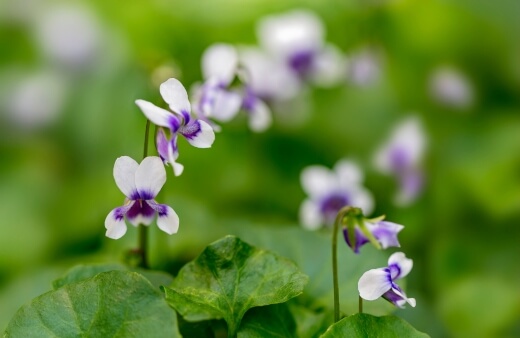
Do native violets spread?
Native violets spread prolifically if left uncontrolled, but are easy to dig up and divide so they are suitable for most gardens. They require minimal nutrients so are unlikely to affect other plants in your garden, and help reduce other weeds by blocking out light to the soil.
How long do native violets take to grow?
Native violets go from seed to flowering in under a year. Seeds will germinate and be ready to plant out after 4-8 weeks depending on conditions they will root and spread to around 2m after 2-3 years.
Do native violets grow in full sun?
Native violets grow best in partial shade, but flower best in slightly brighter conditions. Getting the balance right can be enough, but they are hardy plants that don’t mind being moved. To begin with, try planting native violets in dappled sun.
Can you mow native violets?
If you’ve opted for a native violet lawn, you’ve made a good choice. Native violets spread in a similar way to most lawn grasses, and have the added bonus of beautiful flowers for most of the year.
As flowers die back they can leave unsightly seed pods behind. Mowing a native violet lawn three or four times a year will help to keep it looking tidy and reduce the spread of seeds to other parts of the garden.
Wrapping Up Our Native Violet Guide
Australian native violets are amongst the most beautiful native plants we have. They might not have the stunning beauty of some of our more tropical species, but there’s something stunningly simple about their delicate flowers and rolling mounds of foliage that shouldn’t be underestimated.
If you’re considering growing native violets as ground cover, or even as a lawn replacement, make sure you get the soil conditions right before planting.
If you’re growing native violet as bush tucker, find a good pot and some moisture-retentive compost, and you’re all set. Now you know how to grow native violets, there’s nothing stopping you!
Published on September 21, 2022 by Lorri Hopkins
Last Updated on January 26, 2025




